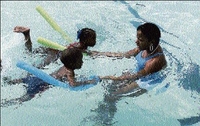
As the summer heat increases, many of us are going to the beach or the river. Thus, we need to be more aware of water safety. Knowledge about water safety and confidence while swimming or playing in the water are the main tools for preventing accidents and drowning.
If we know basic survival skills, safe swimming rules, use personal floatation devices and know rescue techniques, we should be safe in the water. We cannot be considered water safe until we are comfortable in deep water.
It is important to learn to float and to use this technique to gain confidence and control and avoid difficulties in the water. It is more difficult to float in freshwater than seawater. If we get into difficulty in the water, breath control is the most important factor in restoring control and keeping afloat.
Back float
The back float is a fairly simple water-survival skill. Lie on your back, and move your chin up as high as you can. Bring your chest up to the water surface and relax. You can stretch your arms out to the side to improve your balance. If your legs tend to sink, arch your back and inhale deeply. Your face should be out of the water. Do some slow, relaxed arm strokes if you feel like you are losing balance.
Survival float
Let's learn to float in a relaxed position. Take a deep breath and let your body submerge. Allow your arms and legs to hang in a relaxed manner. Your back should come close to the surface. Hold your breath but do not wait until you have to breathe out. When you decide to breathe, move your arms close to the surface, move your legs apart as in scissors kicks and start to breathe out. Push your hands down on the water, complete the scissors kick and place your head backwards. You only need to get your face out of the water. Breathe in quickly and go back to the original position.
Treading water
Treading water is an important water-safety skill. Move your arms and make wide circular scooping motions with your palms turned down. Apply constant pressure with your hands as you move them back and forth. Various types of leg kicks can be used during treading. The scissors kick involves one leg going forward and the other going backwards. The breaststroke kick is also used frequently. The most consistent support of all the kicks is the egg beater. It is a breaststroke kick where the legs kick alternately instead of simultaneously. Try the various leg strokes and use the one that you find most comfortable.
Dr Kenneth Gardner is an exercise physiologist at Holiday Hills Research Center; email: yourhealth@gleanerjm.com.
